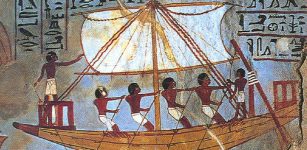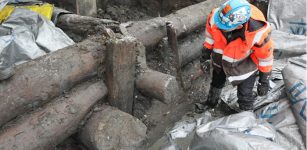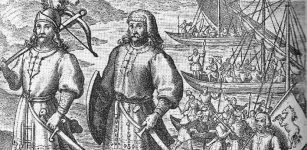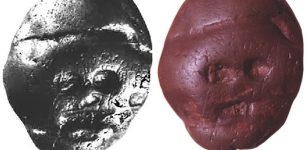Copiale Cipher – Secrets Of Mysterious Coded Manuscript And The Oculist Order
Ellen Lloyd - AncientPages.com - Undeciphered for more than 260 years, the Copiale cipher has baffled experts trying to unravel the secrets behind this puzzling manuscript.
The 18th-century handwritten, encrypted manuscript, covering 105 pages, contains peculiar abstract symbols mixed with Roman and Greek letters. Scientists have struggled to decode the 75,000 characters found in the Copiale cipher, and its secrets have finally been revealed.
Copiale Cipher pages 16-17. Credit: Kevin Knight, Beáta Megyesi, Christiane Schaefer, Public Domain
Using sophisticated computer programs, we know today that the Copiale cipher was created by a secret society based in Germany.
Researchers from the United States and Sweden have discovered that the cryptogram, written on gold and green brocade paper, contains rituals and political leanings of a secret society known under the name the "Oculist Order" of Wolfenbüttel.
It is estimated that the Copiale cipher dates back to 1760 -1780. The unusual document was discovered in the East Berlin Academy after the Cold War and is now in a private collection.
Researchers who cracked the cipher learned that members of the Oculist Order who used the manuscript were not doctors, but they were fascinated with eye surgery and ophthalmology.
When scientists studied the document, they observed how the first meaningful words of German emerged: "Ceremonies of Initiation," followed by "Secret Section."
The manuscript Copiale cipher contains an elaborate Oculist initiation ceremony and instructions on how to conduct rituals that focus on the purpose of the eye. As previously mentioned on Ancient Pages, the Eye of Providence, also known as the All Seeing Eye, is a powerful symbol used for hundreds of years. It was of particular importance to various secret societies.
Though it has not been confirmed, it appears as if the owner of the Copiale Cipher was someone named "Philipp 1866". This name is visible on the flyleaf. The manuscript doesn't contain any plain text except the word "Copiales 3".
It is uncertain, but it seems that this trace leads to Count Friedrich August von Veltheim, who founded the Oculists Order in 1742. The Oculist Order was a secret society that called its members "high enlightened." According to the members, the goal was to create a peaceful community that coexisted and worked together with all nations, races, and religions. Historians have determined members of the Oculist Order were Freemasons who had established the society to pass down Masonic rites.
Copiale Cipher pages 16-17. Credit: Kevin Knight, Beáta Megyesi, Christiane Schaefer, Public Domain
Pope Clement XII (1652 -1740) condemned Freemasonry and banned the secret society of the Oculist Order.
Researchers could have cracked the code sooner, but they focused too much on the Roman and Greek characters. It turned out that the Roman characters were "nulls" intended to mislead the reader. The abstract symbols held the secret message.
The use of ciphers goes far back in time. People always wanted to communicate securely. Some ciphers have deluded our modern computers, but many have been cracked.
Sometimes ciphers do not have to be complicated in order to be effective. Ancient Rome's dictator and general Julius Caesar turned the Roman Republic into a powerful Roman Empire, but he had a lot of enemies.
He used a simple yet efficient code when he sent messages to his generals. The Caesar Cipher was long impossible to break, but one day it was cracked too.
Updated on June 7, 2022
Written by Ellen Lloyd – AncientPages.com
Copyright © AncientPages.com All rights reserved. This material may not be published, broadcast, rewritten or redistributed in whole or part without the express written permission of AncientPages.com
Expand for referencesMore From Ancient Pages
-
 Mysterious Sherbrooke Stones – Did Africans Visit North America 2,500 Years Ago?
Artifacts | Nov 23, 2017
Mysterious Sherbrooke Stones – Did Africans Visit North America 2,500 Years Ago?
Artifacts | Nov 23, 2017 -
 Discovered 2000-Year-Old Mauryan Structure May Lead To The Lost Ashoka Pillar Site
Archaeology | Sep 30, 2021
Discovered 2000-Year-Old Mauryan Structure May Lead To The Lost Ashoka Pillar Site
Archaeology | Sep 30, 2021 -
 Rare Animal-Shaped Mounds Discovered In Peru
Archaeology | Apr 2, 2012
Rare Animal-Shaped Mounds Discovered In Peru
Archaeology | Apr 2, 2012 -
 Ancient Sound Of Stones – Acoustics At Stonehenge Tested By Scientists
Ancient Technology | Aug 29, 2020
Ancient Sound Of Stones – Acoustics At Stonehenge Tested By Scientists
Ancient Technology | Aug 29, 2020 -
 Kaupang – Flourishing Viking Town – A Commercial Hub And Transit Port For North Sea Trade
Featured Stories | Feb 2, 2023
Kaupang – Flourishing Viking Town – A Commercial Hub And Transit Port For North Sea Trade
Featured Stories | Feb 2, 2023 -
 The Perplexing Story Of The Seven Continents And The Seven Mysterious Races – Can The Past Foretell The Future? – Part 2
Ancient Mysteries | May 15, 2022
The Perplexing Story Of The Seven Continents And The Seven Mysterious Races – Can The Past Foretell The Future? – Part 2
Ancient Mysteries | May 15, 2022 -
 Why Did Archaeologists Destroy Medieval King’s Wharf After Excavations?
Archaeology | May 17, 2023
Why Did Archaeologists Destroy Medieval King’s Wharf After Excavations?
Archaeology | May 17, 2023 -
 Did Democracy Have A Separate Origin In The Americas?
Archaeology | Jun 15, 2022
Did Democracy Have A Separate Origin In The Americas?
Archaeology | Jun 15, 2022 -
 ‘Giants’ Discovered In Ancient Grave In China
Archaeology | Jul 6, 2017
‘Giants’ Discovered In Ancient Grave In China
Archaeology | Jul 6, 2017 -
 Did An Extraterrestrial Spacecraft Land In Ancient China? Remarkable UFO Accounts From The Past
Ancient Mysteries | Nov 17, 2014
Did An Extraterrestrial Spacecraft Land In Ancient China? Remarkable UFO Accounts From The Past
Ancient Mysteries | Nov 17, 2014 -
 Elusive Non-Binary Gender In Prehistoric Europe – A Forgotten Minority
Archaeology | May 26, 2023
Elusive Non-Binary Gender In Prehistoric Europe – A Forgotten Minority
Archaeology | May 26, 2023 -
 Pharaoh Ay – A Man With A Hidden Agenda Or A Victim Of Unfortunate Circumstances?
Featured Stories | Feb 5, 2019
Pharaoh Ay – A Man With A Hidden Agenda Or A Victim Of Unfortunate Circumstances?
Featured Stories | Feb 5, 2019 -
 Mystery Of Egyptian Queen Hetepheres I’s Bracelets Solved!
Archaeology | Jun 2, 2023
Mystery Of Egyptian Queen Hetepheres I’s Bracelets Solved!
Archaeology | Jun 2, 2023 -
 Prehistoric Feces At Stonehenge Reveal The Earliest Evidence For Intestinal Parasites In The UK
Archaeology | May 21, 2022
Prehistoric Feces At Stonehenge Reveal The Earliest Evidence For Intestinal Parasites In The UK
Archaeology | May 21, 2022 -
 Rare Ancient Precious Artifacts Found In Rusovce, Slovakia
Artifacts | Sep 26, 2015
Rare Ancient Precious Artifacts Found In Rusovce, Slovakia
Artifacts | Sep 26, 2015 -
 Hengist And Horsa: Legendary Anglo-Saxon Warrior Brothers And Leaders Of First Settlers In Britain
Featured Stories | May 28, 2016
Hengist And Horsa: Legendary Anglo-Saxon Warrior Brothers And Leaders Of First Settlers In Britain
Featured Stories | May 28, 2016 -
 Why Are Manuports Like The Makapansgat Cobble Interesting Archaeological Artifacts?
Artifacts | Mar 15, 2024
Why Are Manuports Like The Makapansgat Cobble Interesting Archaeological Artifacts?
Artifacts | Mar 15, 2024 -
 13th Century Black Book Of Carmarthen: Erased Poetry And Ghostly Faces Revealed By UV Light
Artifacts | Apr 4, 2015
13th Century Black Book Of Carmarthen: Erased Poetry And Ghostly Faces Revealed By UV Light
Artifacts | Apr 4, 2015 -
 Acheulian Culture Of Ethiopian Highlands And Their Prehistoric Tool Selection To Make Society’s Life Easier
Archaeology | Jan 10, 2025
Acheulian Culture Of Ethiopian Highlands And Their Prehistoric Tool Selection To Make Society’s Life Easier
Archaeology | Jan 10, 2025 -
 DNA Sheds New Light On The Mysterious Dead Sea Scrolls
Archaeology | Jun 2, 2020
DNA Sheds New Light On The Mysterious Dead Sea Scrolls
Archaeology | Jun 2, 2020


